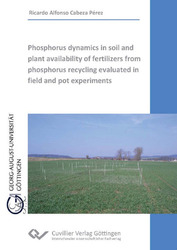| Fachbereiche | |
|---|---|
| Buchreihen (96) |
1378
|
| Nachhaltigkeit |
3
|
| Gesundheitswesen |
1
|
| Geisteswissenschaften |
2364
|
| Naturwissenschaften |
5406
|
| Mathematik | 229 |
| Informatik | 319 |
| Physik | 980 |
| Chemie | 1363 |
| Geowissenschaften | 131 |
| Humanmedizin | 243 |
| Zahn-, Mund- und Kieferheilkunde | 10 |
| Veterinärmedizin | 108 |
| Pharmazie | 147 |
| Biologie | 835 |
| Biochemie, Molekularbiologie, Gentechnologie | 121 |
| Biophysik | 25 |
| Ernährungs- und Haushaltswissenschaften | 45 |
| Land- und Agrarwissenschaften | 1004 |
| Forstwissenschaften | 201 |
| Gartenbauwissenschaft | 20 |
| Umweltforschung, Ökologie und Landespflege | 148 |
| Ingenieurwissenschaften |
1793
|
| Allgemein |
98
|
|
Leitlinien Unfallchirurgie
5. Auflage bestellen |
|
Erweiterte Suche
Phosphorus dynamics in soil and plant availability of fertilizers from phosphorus recycling evaluated in field and pot experiments
Ricardo Alfonso Cabeza Pérez (Autor)Vorschau
Inhaltsverzeichnis, Datei (57 KB)
Leseprobe, Datei (94 KB)
The limited P resources make it necessary to recover P from waste materials. Different chemical and thermal processes are given resulting in P-fertilizers with different availability to the plants. We tested the P availability of recycled P products in comparison to standard P fertilizers triple superphosphate (TSP) and rock phosphate (RP) in a pot experiment. The experiment was performed on an acid (pH 4.4) and a neutral soil (pH 6.8) of low available P. Eight recycled P products were evaluated, 4 from chemical processes (3 magnesium ammonium-phosphate [MAP] of different sewage treatment plants and a precipitated calcium phosphate [Ca-P]) and 4 from thermal processes (a heavy metal depleted sewage sludge [Sl-ash], and alkali sinter phosphate [Sinter P], a cupola furnace slag from sewage sludge [Cupola slag] and a mono-incinerated meat and-bone meal [MB meal ash]). Plant availability was in the following order: in the acid soil, TSP ≥ MAP ≥ precipitate calcium phosphate (Ca-P) ≥ thermal products ≥ rock phosphate (RP). Although the products Sinter-P and Cupola slag were as effective as TSP, the first in the acid soil and the second in a neutral pH soil. To explain the differences in availability the P dynamics after fertilization was evaluated by a fractionation P extraction and the isotopically exchangeable P (IEP). The extractants and the order used in the sequential fractionation procedure were: anion exchange resins (resin-Pi), NaHCO3 0.5 M, NaOH 1 M, HCl 1 M, HCl concentrated and H2SO4 concentrated plus H2O2 (residual P). Phosphorus from MAP products was extracted mainly by resin-Pi, NaHCO3 and NaOH and was comparable to the fate of P from TSP. Ca-P was found mainly in resin-Pi, NaHCO3-Pi and NaOH-Pi in the acid soil. In the neutral soil, the P from Ca-P was not found in resin-Pi but in NaOH-Pi and in HCl 1M Pi. The thermal products were separated in two groups according to the extraction procedure. The P from the products Sinter-P and Cupola slag in the acid soil were found mainly in resin-Pi, NaHCO3-Pi and NaOH-Pi, however the amount of P found in resin Pi was in tendency lower than for TSP. The products Sl-ash and MB meal ash are in the second group, which were similar to RP. The P from these products was mainly found in HCl 1M-Pi fraction. The IEP in soils fertilized with MAP products increased in a similar amount than in soils fertilized with TSP in both soils. Calcium phosphate was more effective in the acid soil Düshorn being similar to the MAP products. The thermal Sinter-P showed an IEP comparable to TSP in the acid soil and the thermal product Cupola slag was similar to TSP in both soils. The other thermal products, Sl-ash and MB meal ash were ineffective to increase the IEP in both soils.
| ISBN-13 (Printausgabe) | 3869554762 |
| ISBN-13 (Printausgabe) | 9783869554761 |
| ISBN-13 (E-Book) | 9783736934764 |
| Sprache | Englisch |
| Seitenanzahl | 166 |
| Auflage | 1 Aufl. |
| Band | 0 |
| Erscheinungsort | Göttingen |
| Promotionsort | Universität Göttingen |
| Erscheinungsdatum | 10.09.2010 |
| Allgemeine Einordnung | Dissertation |
| Fachbereiche |
Land- und Agrarwissenschaften
|








